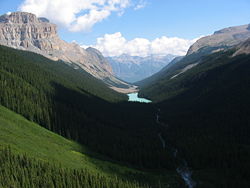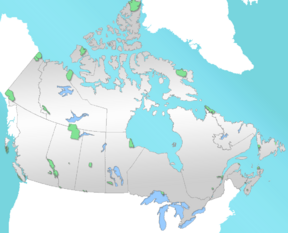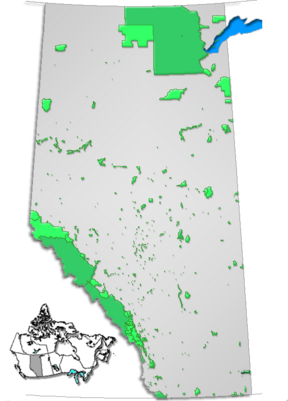Jasper National Park
| Jasper National Park |
| IUCN Category II (National Park) |
|
Jasper Park Location
|
| Location |
Alberta, Canada |
| Nearest city |
Jasper |
| Coordinates |
|
| Area |
10,878 km² |
| Established |
1907 |
| Visitors |
1,988,600 (in 2006[1]) |
| Governing body |
Parks Canada |
| World Heritage Site |
304 |
Jasper National Park is the largest national park in the Canadian Rockies, spanning 10,878 km² (4200 mi²). It is located in the province of Alberta, to the north of Banff National Park and west of the city of Edmonton. The park includes the glaciers of the Columbia Icefield, hot springs, lakes, waterfalls and, of course, mountains. Wildlife in the park includes elk, caribou, moose, mule deer, white-tailed deer, mountain goat, bighorn sheep, grizzly bear, black bear, beaver, Rocky Mountain pika, hoary marmot, gray wolf, mountain lion, and wolverine.
History
Jasper was named after Jasper Hawes, who operated a trading post in the region for the North West Company. Before this it was referred to as Fitzhugh. The park was established on September 14, 1907 as Jasper Forest Park, and was granted national park status in 1930, with the passing of the National Parks Act.[2]
In 2006, Jasper National Park had 1,988,600 visitors.[1]
World Heritage Site
This park was declared a UNESCO World Heritage Site in 1984, together with the other national and provincial parks that form the Canadian Rocky Mountain Parks, for the mountain landscapes containing mountain peaks, glaciers, lakes, waterfalls, canyons and limestone caves as well as fossils found here.
Geography
Major river systems originating in the park include the North Saskatchewan River (part of the Hudson Bay basin), the Athabasca River and Smoky River (part of the Arctic Ocean basin).
Attractions

Fryatt Valley from the top of the head wall.
Some of the park's many photogenic vistas include Mount Edith Cavell, Pyramid Lake with Pyramid Mountain, Maligne Lake, Medicine Lake, and the Tonquin Valley all considered best photographed at sunrise except for Maligne Lake, which is best in the evening. Other attractions are the Marmot Basin ski area, the Snocoach (bus-sized snowmobile) tours of the Athabasca Glacier, a distributary of the Columbia Icefield, Athabasca Falls, Maligne Lake, Whistler Sky-Tram the Jasper Tramway, and numerous other outdoor related recreational activities (such as hiking, fishing, wildlife viewing, rafting, kayaking and camping). The Miette Hotsprings are located close to the northeast entrance.The Miette Hotsprings is created by an extremely hot spring cooled by the mountain to just the right temperature for humans to use. It is the most natural hot tub in the world.
Among the most stunning of attractions is the Icefields Parkway, a highway 230 km (143 miles) in length from Lake Louise, Alberta in Banff National Park, to Jasper, Alberta. The highway parallels the continental divide, providing motor and cycle access to glorious mountain scenery. Along the highway travellers can take in both the Athabasca, and Sunwapta Falls which are easily accessible. An aerial view of the one of the falls can be seen here.
Photo gallery
See also
References
External links
 National Parks of Canada National Parks of Canada |
|
| National parks |
Aulavik · Auyuittuq · Banff · Bruce Peninsula · Cape Breton Highlands · Elk Island · Forillon · Fundy · Georgian Bay Islands · Glacier · Grasslands · Gros Morne · Ivvavik · Jasper · Kejimkujik · Kluane · Kootenay · Kouchibouguac · La Mauricie · Mount Revelstoke · Point Pelee · Prince Edward Island · Pukaskwa · Prince Albert · Quttinirpaaq · Riding Mountain · Sirmilik · St. Lawrence Islands · Terra Nova · Thaydene Nene · Tuktut Nogait · Ukkusiksalik · Vuntut · Wapusk · Waterton Lakes · Wood Buffalo · Yoho |
|
| National Park Reserves |
Gulf Islands · Gwaii Haanas · Kluane · Mingan Archipelago · Naats'ihch'oh · Nahanni · Pacific Rim · Torngat Mountains
|
|
| Marine Conservation Areas |
Fathom Five · Lake Superior · Saguenay-St. Lawrence
|
|
| National Landmark |
Pingo
|
|
|
Parks in Alberta |
|
| World Heritage Sites |
Canadian Rocky Mountain Parks · Dinosaur Provincial Park · Head-Smashed-In Buffalo Jump · Waterton-Glacier International Peace Park · Wood Buffalo National Park · more... |
|
|
| National parks |
Banff · Elk Island · Jasper · Waterton Lakes · Wood Buffalo · more...
|
|
| Provincial parks |
Cypress Hills · Dry Island Buffalo Jump · Kananaskis Country · Lakeland · Fish Creek · Vermilion · Willmore Wilderness · Writing-on-Stone · more...
|
|
| Urban parks |
Calgary Zoo · Devonian Botanical Garden · Devonian Gardens · Muttart Conservatory · North Saskatchewan River Valley · Nose Hill · Oldman River Valley · Valley Zoo
|
|
| Museums and historic sites |
Cold Lake Air Force · Fort Calgary · Fort Edmonton Park · Fort Victoria · Frank Slide · Galt Historic Railway Park · Heritage Park · Pioneer Acres · Reynolds-Alberta · Royal Alberta · Royal Tyrrell · Ukrainian Village · Whyte · National historic sites · Provincial historic sites
|
|
 Canadian Rockies Canadian Rockies |
|
| Ranges |
Ball · Bare · Beaverfoot · Blue · Bow · Crowsnest · Elk · Fairholme · High Rock · Kananaskis · Maligne · Massive · Misty · · Palliser · President · Queen Elizabeth · Rainbow · Ram · Sawback · Sir Winston Churchill · Slate · South Jasper · Vermilion · Victoria Cross · Waputik · Continental Ranges · Hart Ranges · Muskwa Ranges
|
|
| Mountains |
Alberta · Andromeda · Assiniboine · Athabasca · Brazeau · Bryce · Cascade · Castle · Clemenceau · Columbia · Edith Cavell · Forbes · Hungabee · Joffre · Kitchener · Lyell · Heart · Pilot · Pyramid · Robson · Rundle · Sarbach · Smythe · Snow Dome · Temple · Three Sisters · Twin · Mountains of Alberta · Valley of the Ten Peaks
|
|
| Passes |
Abbot · Athabasca · Bush · Crowsnest · Elbow · Howse · Kicking Horse · Pine · Sinclair · Sunwapta · Wapiti · Yellowhead
|
|
| Glaciers |
Athabasca · Bow · Columbia Icefield · Crowfoot · Hector · Peyto · Saskatchewan · Vulture · Wapta · Waputik Icefield
|
|
| Parks |
|
National
|
Banff · Jasper · Kootenay · Yoho · Waterton Lakes
|
|
|
Provincial (AB)
|
Bow Valley · Bragg Creek · Elbow-Sheep · Kananaskis · Peter Lougheed · Sheep River · Spray Valley · Willmore
|
|
|
Provincial (BC)
|
Akamina-Kishinena · Close-To-The-Edge · Dune Za Keyih (Frog-Gataga) · Graham-Laurier · Hamber · Height of the Rockies · Hole-in-the-Wall · Kakwa · Kikomun Creek · Kwadacha · Mount Assiniboine · Mount Fernie · Mount Robson · Muncho Lake · Northern Rocky Mountains · Pine Le Moray · Stone Mountain
|
|
|
| Ski resorts |
Castle Mountain · Fernie · Fortress Mountain · Lake Louise · Marmot Basin · Mount Norquay · Nakiska · Powder King · Sunshine Village
|
|
| Communities |
Banff · Canmore · Crowsnest Pass · Elkford · Fernie · Field · Jasper · Lake Louise · Sparwood · Tumbler Ridge
|
|
 World Heritage Sites in Canada World Heritage Sites in Canada |
|
| Canada |
Canadian Rocky Mountain Parks · Dinosaur Provincial Park · Gros Morne · Head-Smashed-In Buffalo Jump · Joggins Fossil Cliffs · L'Anse aux Meadows · Old Town Lunenburg · Miguasha · Nahanni · Old Quebec · Rideau Canal · SGaang Gwaay · Wood Buffalo
|
|
| Canada / USA |
Kluane-Wrangell-St. Elias-Glacier Bay-Tatshenshini-Alsek · Waterton-Glacier International Peace Park
|
|


